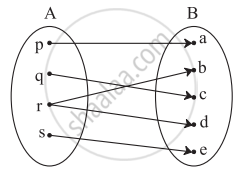Advertisements
Advertisements
प्रश्न
Check the injectivity and surjectivity of the following function.
f : R → R given by f(x) = x2
उत्तर
f : R → R given by f(x) = x2
f(x1) = f(x2), x1, x2 ∈ R
∴ x12 = x22
∴ x12 – x22 = 0
∴ (x1 + x2) (x1 – x2) = 0
∴ x1 = x2 or x1 = – x2
∴ f is not injective.
Therefore all negative integers of codomain are not images under f.
∴ f is not surjective.
APPEARS IN
संबंधित प्रश्न
Let X = {1, 2, 3, 4} and Y = {1, 5, 9, 11, 15, 16}
Determine which of the set are functions from X to Y.
(a) f1 = {(1, 1), (2, 11), (3, 1), (4, 15)}
If f(x) = x2, find \[\frac{f\left( 1 . 1 \right) - f\left( 1 \right)}{\left( 1 . 1 \right) - 1}\]
If f(x) = x2 − 3x + 4, then find the values of x satisfying the equation f(x) = f(2x + 1).
If f(x) = (x − a)2 (x − b)2, find f(a + b).
Let f and g be two real functions defined by \[f\left( x \right) = \sqrt{x + 1}\] and \[g\left( x \right) = \sqrt{9 - x^2}\] . Then, describe function:
(iii) f g
Let f and g be two real functions defined by \[f\left( x \right) = \sqrt{x + 1}\] and \[g\left( x \right) = \sqrt{9 - x^2}\] . Then, describe function:
(vii) f2 + 7f
Let f and g be two functions given by
f = {(2, 4), (5, 6), (8, −1), (10, −3)} and g = {(2, 5), (7, 1), (8, 4), (10, 13), (11, −5)}.
Find the domain of f + g
Which of the following are functions?
If ƒ(m) = m2 − 3m + 1, find f(x + 1)
If f(x) = `{(x^2 + 3"," x ≤ 2),(5x + 7"," x > 2):},` then find f(0)
Check if the following relation is a function.

If f(m) = m2 − 3m + 1, find `f(1/2)`
Find x, if g(x) = 0 where g(x) = `(5x - 6)/7`
Find the domain and range of the following function.
f(x) = 7x2 + 4x − 1
Find the domain and range of the following function.
f(x) = `root(3)(x + 1)`
Find the domain and range of the following function.
f(x) = `sqrt((x - 2)(5 - x)`
Check the injectivity and surjectivity of the following function.
f : N → N given by f(x) = x3
Express the following exponential equation in logarithmic form
e–x = 6
Express the following logarithmic equation in exponential form
`log_(1/2) (8)` = – 3
If x = loga bc, y = logb ca, z = logc ab then prove that `1/(1 + x) + 1/(1 + y) + 1/(1 + z)` = 1
If f(x) = 3x + 5, g(x) = 6x − 1, then find (f + g) (x)
If f(x) = 3x + 5, g(x) = 6x − 1, then find (f − g) (2)
If f(x) = 3x + 5, g(x) = 6x − 1, then find (fg) (3)
Select the correct answer from given alternatives.
If log10(log10(log10x)) = 0 then x =
Select the correct answer from given alternatives.
Find x, if 2log2 x = 4
Answer the following:
Let f: R → R be a function defined by f(x) = 5x3 – 8 for all x ∈ R, show that f is one-one and onto. Hence find f –1
Answer the following:
Let f : R – {2} → R be defined by f(x) = `(x^2 - 4)/(x - 2)` and g : R → R be defined by g(x) = x + 2. Examine whether f = g or not
Answer the following:
Let f : R → R be given by f(x) = x3 + 1 for all x ∈ R. Draw its graph
Answer the following:
Show that, `log ("a"^2/"bc") + log ("b"^2/"ca") + log ("c"^2/"ab")` = 0
Given the function f: x → x2 – 5x + 6, evaluate f(2a)
The domain of the function f(x) = log3+x (x2 - 1) is ______.
Find the domain of the function f given by f(x) = `1/sqrt([x]^2 - [x] - 6)`
If f(x) = `x^3 - 1/x^3`, then `f(x) + f(1/x)` is equal to ______.
Find the domain of the following functions given by f(x) = `1/sqrt(x + |x|)`
Range of f(x) = `1/(1 - 2 cosx)` is ______.
The range of the function y = `1/(2 - sin3x)` is ______.
Which of the following functions is NOT one-one?
The domain of f(x) = `sin^-1 [log_2(x/2)]` is ______.
